The Unconscious Mind – What is the Unconscious?
Key Points:
- In the psychological sense, the unconscious (mind) represents the mental processes that occur outside of our conscious awareness.
- Non-conscious processing includes all thoughts, memories, biases, and attitudes that influence our decisions without our conscious awareness.
- Meditation, mindfulness, and habit building enable us to influence our unconscious processing indirectly.
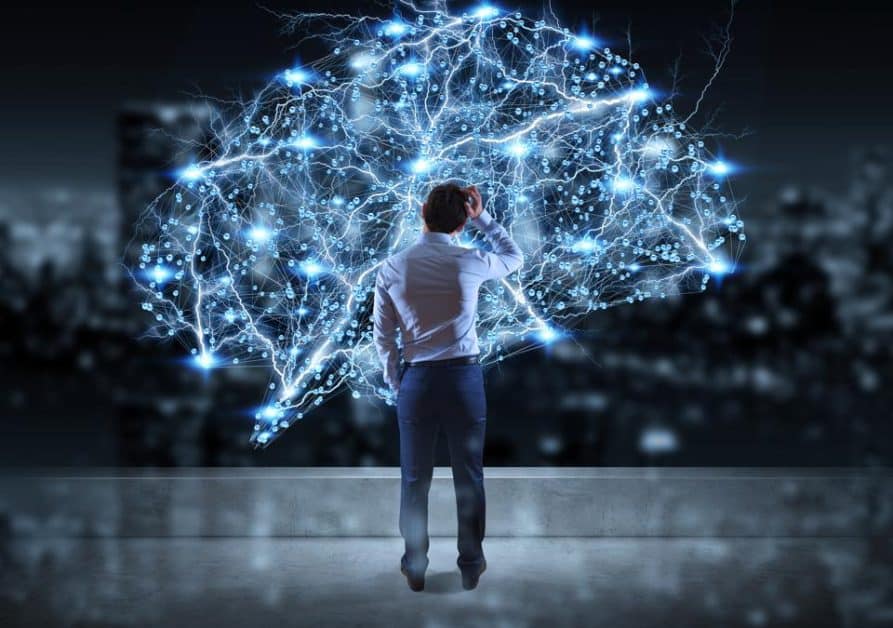
Jump to:
The realm of the unconscious has held a mysterious yet influential presence in humanity since antiquity. Many cultures, such as those seen in the Vedas Hindu texts between 2,500 and 600 BC, explored the idea of internalized unconscious processes, associating them with elements of the divine and the role of gods.
Over the past century, however, psychological and cognitive sciences have explored the validity of the unconscious with greater scientific rigor. While the notion of an “unconscious mind” still raises much controversy within the scientific community, the effects of non-conscious mental processes – what we recognize as unconscious thoughts, feelings, and memories – clearly influence many of our day-to-day decisions.
Even for those with the best intentions, unconscious processes often appear to be the dominant controlling force on behavior. While non-conscious thoughts can lead to self-sabotage, biases, and poor decision-making, they can also prove beneficial.
This article will provide an overview of exactly what is meant by the unconscious mind, what role it plays in everyday life, and what modern science reveals about this controversial topic.
What is the Unconscious?
Part of the confusion and mystery surrounding the unconscious lies in its myriad definitions. Physiologically, unconsciousness is the lack of responsiveness to people and other external stimuli, like when a boxer is knocked unconscious after losing a fight.
Of greater interest, however, is the psychological and neuroscientific definitions. Here, the unconscious mind (or the unconscious) consists of mental processes (thoughts, emotions etc) that occur automatically without conscious input, and are not available for introspection.
This includes thoughts, memories, interests, and motivations that affect your behavior without your awareness. Psychological pioneers, such as Sigmund Freud and Carl Jung, famously defined unconsciousness as the part of the mind operating well outside the awareness of the conscious mind.
What are the Results of the Unconscious Mind?
Because the unconscious mind is, by definition, inaccessible through conscious thought, we can only explore it through its effects on our behavior.
Empirical evidence suggests that unconscious behavior manifests through repressed feelings, automatic habits and skills, subliminal perceptions, and automatic reactions. It is also thought to be responsible for seemingly irrational psychological complexes, such as hidden phobias, and desires.
The unconscious mind is often thought to be the source of dreams, forgotten memories, and implicit thoughts (those that appear without apparent cause or reason). Implicit knowledge (the things we have learned and repeated so frequently that they become automatic) is also thought to be unconscious.
As a result of these deep reactions and responses, much of our internal beliefs and biases stem from what has been programmed into our unconscious minds throughout our lives. Those who are raised in strict environments, such as religious or political families, may have their beliefs and behaviors severely influenced without their conscious awareness.
Unconscious Vs. Subconscious
According to Freud, the collective mind can be split into three related yet distinguished parts:
Freud's 3-Mind Model
- The Conscious mind – defines all thoughts and actions within our awareness.
- The Subconscious/Preconscious – defines all reactions and automatic actions we can become aware of when we choose to.
- The Unconscious – defines all past events and memories, though at times inaccessible to us no matter how hard we try to remember to bring things up. Often these are intensely negative memories stored in the brain that can affect our thoughts and actions without our conscious awareness.
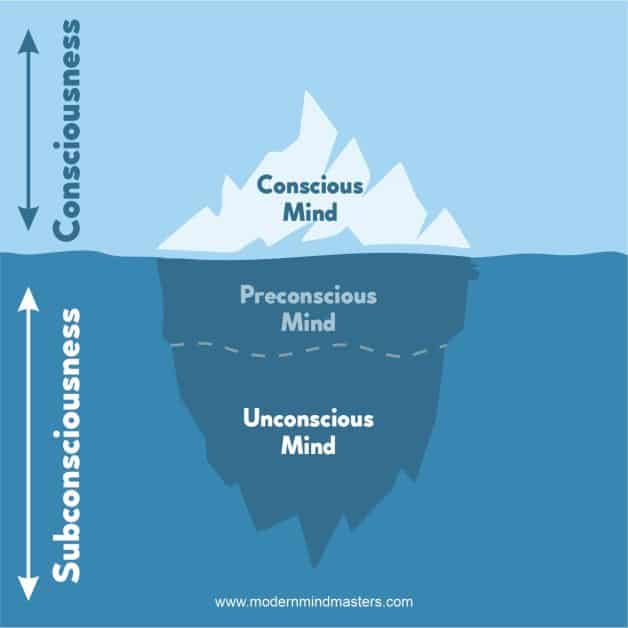
The term subconscious is often used when the unconscious is technically more appropriate. The subconscious is better thought of as a “catch-all” and non-technical term for non-conscious thoughts and processes.
The unconscious, however, is more specific. Popularized by Freud, it refers to inaccessible thoughts that we cannot directly recall and remain outside the influence of conscious thought. He dropped his previous use of the subconscious in favor of the unconscious because, in his opinion, it failed to differentiate whether thoughts and feelings occurred in the unconscious or preconscious mind.
Subconscious thoughts, including what Freud defined as the preconscious, include processes that currently remain outside of conscious awareness but could be brought into awareness should we choose to.
For example, not immediately remembering your brother’s phone number, but recalling it after concentrating for a few seconds, would be a subconscious process, not an unconscious one.
Unconscious memories are not available to introspection, and thus cannot be recalled as subconscious/preconscious ones can.
The defining feature of unconscious processes is our inability to directly access them. They are triggered by specific environmental factors, such as the smell of liquor releasing horrible memories of drunken abuse by a close relative.
Unconscious memories are wired into our programming but run so deep that we are usually not aware of them. They have a strong effect on our beliefs and biases and therefore affect most of our decisions and behaviors.
You almost certainly have unconscious beliefs wired into your brain that affect or influence every decision you make, even without your knowledge. These include social stigmas, racial biases, and a sense of justice.
Freud and The Unconscious
Although the idea of non-conscious processes has been theorized since antiquity, the concept was popularized by psychoanalyst Sigmund Freud. In psychoanalytic theory, unconscious processes are thought to be manifested through dreams and slips of the tongue (hence the term Freudian slip).
Freud viewed the unconscious as the source of socially unacceptable ideas, wishes or desires, traumatic memories, and painful emotions repressed from conscious thought and stored in the unconscious.
While Freud’s works were revolutionary for the time and created a strong foundation upon which much of modern cognitive science developed, he later used his notion of the unconscious to explain certain kinds of neurotic behavior.
Some of his more questionable theories include the now infamous Oedipus complex, a universal phase in the life of a young boy in which he unconsciously wishes to have sex with his mother while reviling his father for having sex before him.
While Freud’s work served as the foundation upon which the science of consciousness later developed, his works are now mostly seen as pseudoscience. While some of his more neurotic theories certainly tilter on the boundaries of logic (and sometimes sanity), it is important to remember that little of the rigorous scientific measuring equipment taken for granted today was available to Freud.
Jung and The Unconscious
Swiss psychiatrist Carl Gustav Jung built upon Freud’s theories and further developed the concept of the unconscious mind.
Jung principally agreed with Freud that the unconscious is a determinant of personality, but fleshed out the components of the unconscious into two distinct categories: the personal and collective unconscious.
Collective Unconscious
The collective unconscious refers to all non-conscious thoughts that are ingrained into our nature – a collection of reactions to situations facing all humans since time immemorial. Primal instincts, such as the fight or flight response, are examples of such behavior.
Jung poetically described the collective unconscious as “the whole spiritual heritage of mankind’s evolution, born anew in the brain structure of every individual”, where the collective contains material of the entire species rather than just that of an individual.
It also serves as the deepest level of the psyche and proves extremely difficult to change. Attempting to consciously overcome a fight or flight response, for example, would prove near impossible.
Personal Unconscious
Whereas the collective unconscious focuses on human instincts present in everyone and passed down from millennia of collective experiences, the personal unconscious describes the material that was once conscious but has since been stored, forgotten, or repressed into our subconscious stores.
The personal unconscious includes everything that is not presently in conscious awareness but could be, which Jung described as being “on the fringe of consciousness”. These experiences are personal to you and you alone.
A deep-seated aversion to religion, having been raised in an overly strict religious household, is an example of a personal unconscious belief. Other common examples include a bias against people of certain races, ethnicities, and political groups.
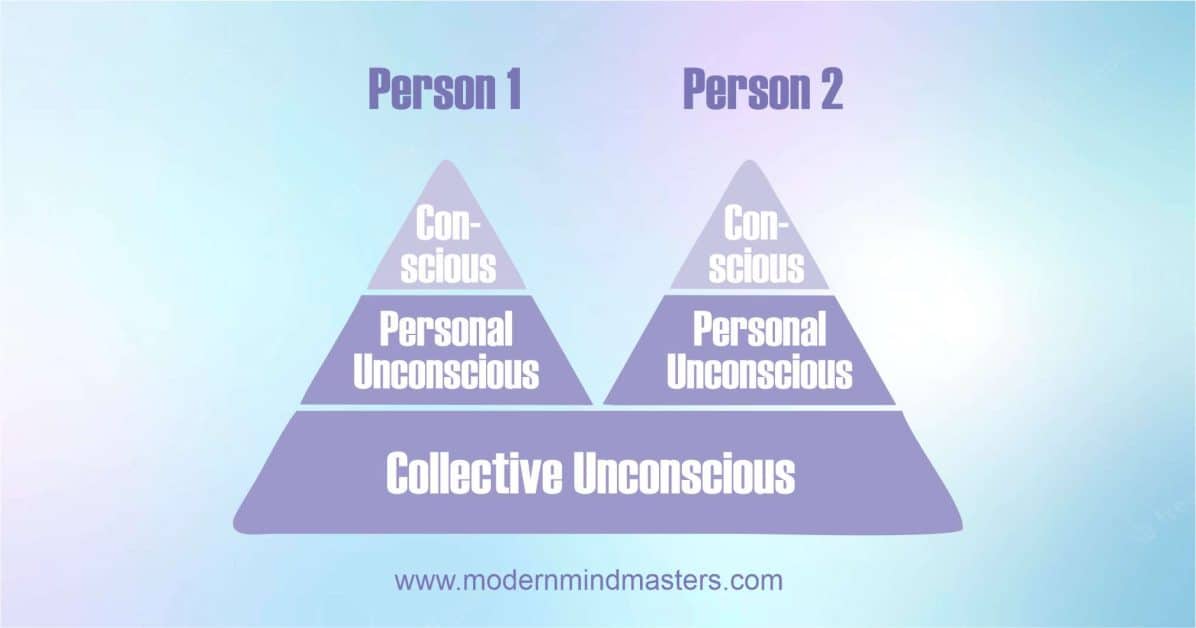
Are you Unconscious When you Sleep?
When we sleep, we are unconscious in the physiological sense, that is, we are not conscious. But the cognitive specifics of what happens when we sleep are still largely unknown.
Freud stated that the purpose of dreams is to fulfill repressed wishes since they cannot be fulfilled in real life. As with many of Freud’s theories, this has largely been discredited.
Neuroscientist Rosalind Cartwright later proposed that dreams provide the opportunity to act out everyday problems and emotional issues in a non-real setting with no consequences.
Allan Hobson, an American psychologist known for his research on rapid eye movement, developed the activation-synthesis hypothesis that states that dreams are simply the side effects of neural activity in the brain.
Beta brain waves produced during REM sleep result in neurons firing periodically in the lower brain levels, which then send random signals to the cortex. The cortex then synthesizes a dream (much like a daydream when awake) to try to make sense of the information sent from the brain.
In this model, dreams occur when the cortex tries to make sense of all the brainwaves released during the REM phase of sleep. This does not mean that dreams are meaningless, just that they are a side-effect of other processes occurring during sleep, and likely not a direct manifestation of emotional unconscious thoughts.
What is an Unconscious Bias?
Also called an implicit stereotype, an unconscious bias is an automatic and involuntary association that people make between a social group and attributes. Common implicit stereotypes include gender bias, racial bias, and group favoritism (cliques).
A commonly quoted implicit bias is the belief that men and women are equally capable at math, yet might associate math-based jobs more with men than women. Despite their conscious beliefs of absolute equality, they are unaware of their unconsciously held biases
Unconscious biases are shaped by a person’s experiences and based on learned associations, social groups, and their particular qualities, usually stemming from their environment and childhood development.
Because people are often unaware of their unconscious biases, they may remain unaware of how their actions and behaviors are harmful to others. It is possible to have a racial implicit bias, for example, while genuinely rejecting the idea explicitly.
Attitudes, stereotypes, prejudices, and bias are some of the potential manifestations of an unconscious bias, all of which can operate outside of your conscious awareness.
Some critics have doubted the existence of the unconscious at all; the psychoanalytic theories from the likes of Freud and Jung are speculative at best, based on anecdotal evidence, and are almost impossible to validate empirically.
Modern branches of science are tackling the subject from an alternative evidence-based angle, however.
Cognitive psychology is one such branch, devoted to the mental activity that lies outside the influence of conscious awareness.
Much of the research has focused on the differences between conscious and unconscious perception, and the different areas of the brain that these two activities activate.
While cognitive psychologists have revealed that the brain can register more information than it can consciously report, they find a more practical explanation of the unconscious in alternative terms such as implicit (information that influences a person’s behavior without their conscious awareness) and automatic (activities that are so easy and often repeated we can do them without thinking).
As such, much of modern cognitive psychology has stripped the notion of the unconscious from its psychoanalytic roots while promoting more practical and physical processing.
Can We Access the Unconscious?
Both psychoanalytic and cognitive definitions of the unconscious believe that the unconscious represents learned information that is forgotten or repressed outside of conscious awareness. The question remains, then, whether this information can be accessed.
By definition, psychoanalysis defines the unconscious as not directly accessible to ordinary introspection because it contains information that was actively repressed out of conscious view.
Psychoanalysts following Freud’s theories of the unconscious traditionally use methods such as meditation, free association, dream analysis, and verbal slips to “tap in” to the unconscious and “interpret” them. Psychoanalysts are therefore considered experts in interpreting unconscious messaging.
Cognitive science casts doubts on these claims, and although they remain prevalent in treatment, cognitive behavioral therapy (CBT) combines cognitive and behavioral therapies, helping clients understand how their emotions, thoughts, and behaviors are related.
Learn to Recognize Unconscious Thoughts
While both CBT and psychotherapy have their proponents and critics, and directly accessing the unconscious remains outside our current ability, we can learn to recognize and identify when non-conscious thoughts affect our behavior indirectly.
If you avoid an opportunity to apply for a promotion or job opportunity, for example, you could recognize that there is no rational explanation for this.
If you get the new job, you only stand to gain, and if you don’t get it, life remains unchanged and nothing is lost. Not wanting to apply, therefore, is a decision based not on logic but emotion, stemming from an unconscious belief that you are not good enough or an unconscious lack of confidence.
While this won’t immediately reveal a direct unconscious reason behind not wanting to at least try for a better working life, it will reveal indirectly unconscious processes working against you out of sight that should be pursued for further investigation.
Rewrite Subconscious Habits and Thoughts
Since unconscious thoughts were created from repressed conscious ones, it makes sense that we might be able to overwrite them with new thoughts using the same mechanism.
While this may prove impossible for automatic non-conscious decisions, such as digestion and other survival-based behaviors, it may be possible to overwrite implicit functions (what Jung termed the personal unconscious) with consciously chosen and beneficial thoughts using the same mechanism with which they were written.
If you have an implicit hatred of exercise, for example, and need to lose weight for health reasons, you would need to overwrite your existing implicit dislike of exercise with one that proves beneficial.
You have to find a sport, such as tennis or football, that you enjoy and would provide the positive emotion to rewrite the previous dislike of exercise.
Related Articles: The Importance of Habits and How To Create Habits That Stick.
Mediate to Expose Your Unconscious Thoughts
Meditation is a technique used to reach a state of mindfulness. Whereas many make the incorrect assumption that mediation should aim to rid you of all thoughts, it is a way to quieten your conscious mind so that you can be free of all judgments and worries.
When successfully achieved, mediation will allow you to quieten your conscious thoughts. When quiet, other subconscious thoughts will invade the space. Mediation, therefore, allows your unconscious thoughts to manifest to the surface as it does when asleep and dreaming.
If you find yourself anxious and cannot put your finger on why meditation may help push the troublesome unconscious thoughts to the surface where you are better able to analyze them.
Conclusion
The unconscious mind, having been clouded by mystery and the divine for millennia, remains a focal point of modern scientific exploration.
While the psychoanalytic theories of Freud and Jung, who pioneered the interest in unconscious forces, are now largely cast aside and seen as speculative, their contribution to the topic must be remembered as the foundation upon which interest in the field was later developed.
An unconscious mind, that is, a physical cognitive store of mental processes, likely does not physically exist, but it is evident that human behavior is affected by non-conscious processes, that is, thoughts, feelings, and memories of which we are not consciously aware.
As technology and neural science improve, it may one day be possible to map unconscious processes to create a detailed picture of the science behind them. Until then, the unconscious is likely to remain shrouded in mystery and controversy, yet highly influential in many of our day-to-day decisions.
The unconscious mind (or the unconscious) consists of mental processes (thoughts, emotions etc) that occur automatically without conscious input, and are not available for introspection.
This includes thoughts, memories, interests, and motivations that affect your behavior without your awareness.
Unconscious memories are wired into our programming but run so deep that we are usually not aware of them. They have a strong effect on our beliefs and biases and therefore affect most of our decisions and behaviors.
While cognitive psychologists have revealed that the brain can register more information than it can consciously report, they find a more practical explanation of the unconscious in alternative terms such as implicit (information that influences a person’s behavior without their conscious awareness) and automatic (activities that are so easy and often repeated we can do them without thinking).
As such, much of modern cognitive psychology has stripped the notion of the unconscious from its psychoanalytic roots while promoting more practical and physical processing.

3 Must-Read Books to Boost Your Social Skills
Humans are unpredictable by nature, so boosting our social skills is one of the strongest weapons we can use for successful communications. Here are 3 of the best books on social skills.

The 5 Best Self-Improvement Books That Actually Work
Here are the 5 best self-improvement books of all time that actually work.

Your Neglected Muscles Are Causing Your Pain – The Importance of Massage
Neglected muscle maintenance causes all manner of symptoms, including lower back pain and headaches. Here’s how to prevent it.
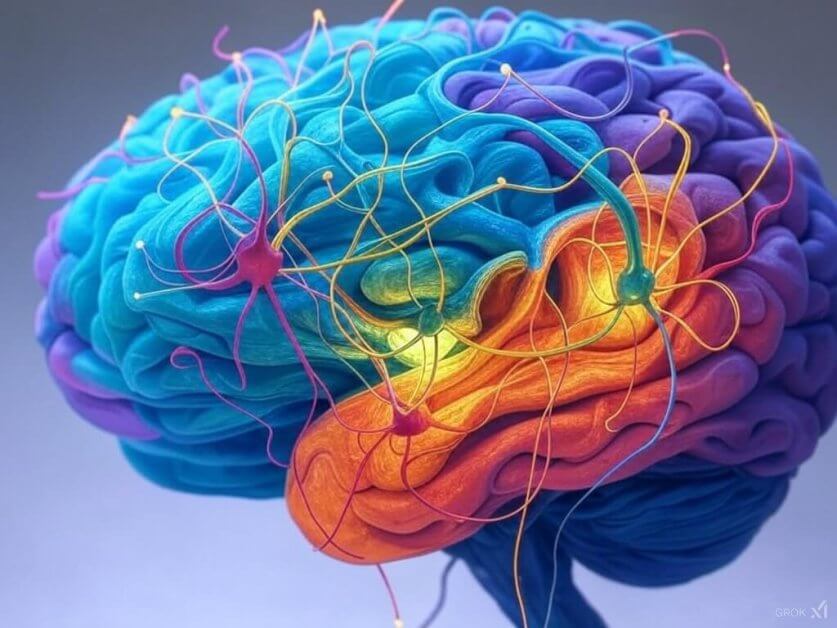
How Exercise Helps The Brain – From Brain Health To Cognitive Performance
Learn how exercise helps the brain, from reduced inflammation, slowed brain aging, and improved cognitive performance.
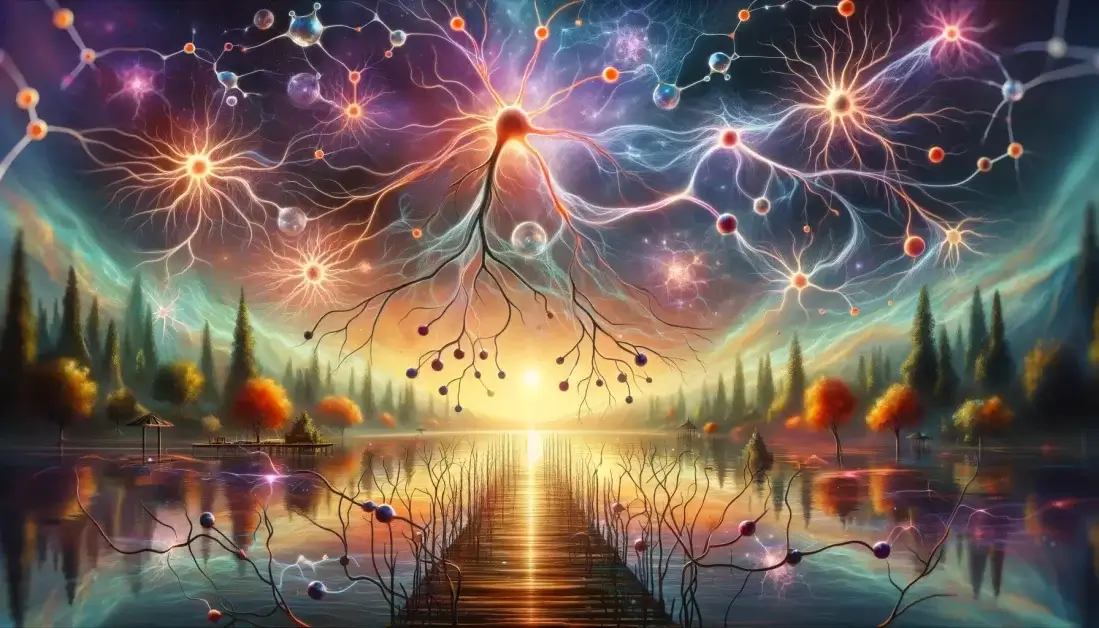
What is GABA: Functions, Benefits, and Effects
GABA is the primary inhibitory neurotransmitter in the brain, preventing over-excitement of neurons to play a critical role in managing anxiety, stress, and sleep.

What is Intermittent Fasting and What are the Benefits?
Intermittent fasting, where we eat across a specific time frame only, unlocks an array of benefits, both psychical and physiological.